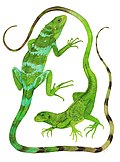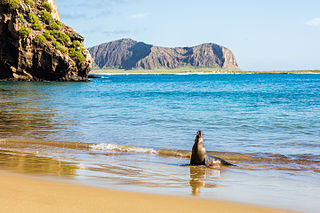
The Galápagos Islands are an archipelago of volcanic islands in the Eastern Pacific, located around the Equator 900 km (560 mi) west of South America. They form the Galápagos Province of the Republic of Ecuador, with a population of slightly over 33,000 (2020). The province is divided into the cantons of San Cristóbal, Santa Cruz, and Isabela, the three most populated islands in the chain. The Galápagos are famous for their large number of endemic species, which were studied by Charles Darwin in the 1830s and inspired his theory of evolution by means of natural selection. All of these islands are protected as part of Ecuador's Galápagos National Park and Marine Reserve.

The Iguanidae is a family of lizards composed of the iguanas, chuckwallas, and their prehistoric relatives, including the widespread green iguana.

The genus Brachylophus consists of four extant iguanid species native to the islands of Fiji and a giant extinct species from Tonga in the South West Pacific. One of the extant species, B. fasciatus, is also present on Tonga, where it has apparently been introduced by humans.

The Galápagos land iguanas comprise the genus Conolophus of the Galápagos Islands (Ecuador). The number of species of this variable genus has always been disputed; the most current taxonomic surveys suggest that three species exist:
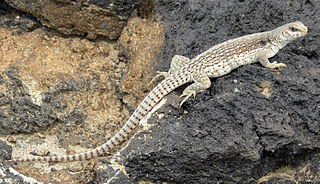
The desert iguana is an iguana species found in the Sonoran and Mojave Deserts of the Southwestern United States and northwestern Mexico, as well as on several Gulf of California islands.

The marine iguana, also known as the sea iguana, saltwater iguana, or Galápagos marine iguana, is a species of iguana found only on the Galápagos Islands (Ecuador). Unique among modern lizards, it is a marine reptile that has the ability to forage in the sea for algae, which makes up almost all of its diet. Marine iguanas are the only extant lizard that spends time in a marine environment. Large males are able to dive to find this food source, while females and smaller males feed during low tide in the intertidal zone. They mainly live in colonies on rocky shores where they bask after visiting the relatively cold water or intertidal zone, but can also be seen in marshes, mangrove swamps and beaches. Large males defend territories for a short period, but smaller males have other breeding strategies. After mating, the female digs a nest hole in the soil where she lays her eggs, leaving them to hatch on their own a few months later.
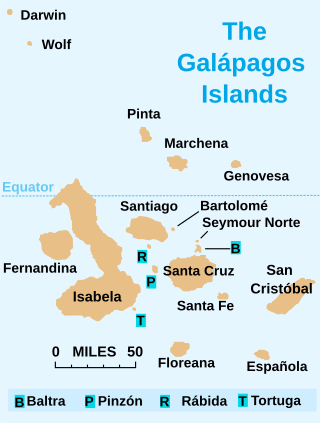
Isabela Island is the largest of the Galápagos Islands, with an area of 4,586 km2 (1,771 sq mi) and a length of 100 km (62 mi). By itself, it is larger than all the other islands in the chain combined and it has a little under 2000 permanent inhabitants. The island straddles the equator.
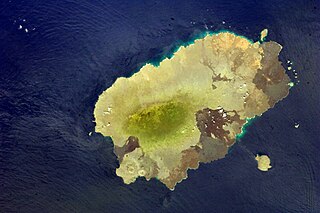
Santiago Island is one of the Galápagos Islands. The island, which consists of two overlapping volcanoes, has an area of 585 square kilometers (226 sq mi) and a maximum altitude of 907 meters (2,976 ft), atop the northwestern shield volcano. The volcano in the island's southeast erupted along a linear fissure and is much lower. The oldest lava flows on the island date back to 750,000 years ago.
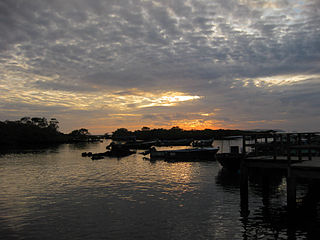
Isabela Canton is a canton of Galápagos Province, Ecuador, consisting of the islands of Isabela Island, Darwin, Fernandina, Wolf, and some minor islets. Isabela is the largest island in the Galápagos, and well known for its beaches, bays and coastal lagoons with a wide variety of plants and birds. The capital of the canton is Puerto Villamil.
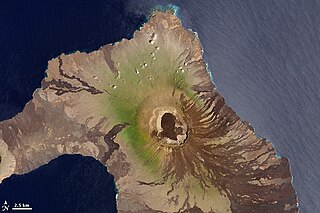
Wolf Volcano, also known as Mount Whiton, is the highest peak in the Galápagos Islands. It is situated on Isabela Island and reaches 1,710 m (5,610 ft). It is a shield volcano with a characteristic upturned soup bowl shape.

Conolophus pallidus is a species of lizard in the family Iguanidae. It is one of three species in the genus Conolophus and is endemic to Santa Fe Island in the Galapagos.
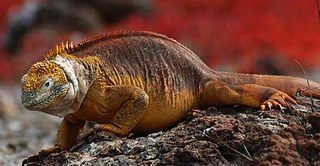
The Galápagos land iguana is a very large species of lizard in the family Iguanidae. It is one of three species of the genus Conolophus. It is endemic to the Galápagos Islands, in the dry lowlands of the islands of Fernandina, Isabela, Santa Cruz, North Seymour, Baltra, and South Plaza.
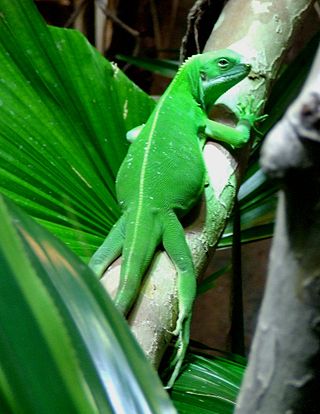
Brachylophus bulabula, commonly known as the Central Fijian Banded Iguana is a species of iguanid lizard endemic to some of the larger central and northwestern islands of Fiji, where it occurs in Fijian wet forest. It was described by a team led by a scientist from the Australian National University in 2008. It is one of the few species of iguana found outside of the New World and one of the most geographically isolated members of the family Iguanidae. Initially also reported from Gau Island, in 2017 this population was described as a separate species, B. gau. They can grow up to 2 feet long and have an average lifespan of 10-15 years. However, there have been some captive Fiji banded iguanas that have lived as long as 25 years. Fijian banded iguana typically are found in tropical wet islands that are typically 650-1700 feet above sea level. They also like to bask in temperatures ranging from 75–95 °F (24–35 °C). The areas that are most suitable for Fiji banded iguanas are Viti Levu, Vanua Levu, Ovalau, Viwa, and Kadavu. Males are typically are green with blue stripes and the females are green with white stripes.
Howard L. Snell is an American ecologist and professor at the University of New Mexico. His research and conservation efforts have focused on the Galapagos land iguanas, which were in danger of extinction.

Microlophus albemarlensis, the Galápagos Lava lizard, also known as the Albemarle Lava lizard, is a species of Lava lizard. It is endemic to the Galápagos Islands, where it occurs on several islands in the western archipelago: the large islands Isabela, Santa Cruz, Fernandina, Santiago and Santa Fe, as well as several smaller islands: Seymour, Baltra, Plaza Sur, Daphne Major and Rábida. It is the most widespread of the Galápagos species of Microlophus, the others only occurring on single islands. Some authors however, consider populations on Santiago, Santa Cruz, and Santa Fe to be distinct species. The species is commonly attributed to the genus Microlophus but has been historically placed in the genus Tropidurus.

Microlophus grayii, also commonly known as the Floreana lava lizard, Gray's lava lizard, and Gray's Pacific iguana, is a species of lava lizard in the family Tropiduridae. The species is endemic to the Galapagos island of Floreana.

Microlophus occipitalis, colloquially known as the knobbed Pacific iguana, is a lizard included within the Tropiduridae family. It is a member of the Microlophus genus and thus also considered a lava lizard. The knobbed Pacific iguana is found primarily in Western Peru and Ecuador, lining the coasts. The habitats of the knobbed Pacific iguana can be considered to be both broad and diverse as they are typically found in many different places such as beaches, lomas, and all the way to desert regions. This diversity is furthered as these lizards can also be found in open areas, between rocks, or bushes.

The Volcán Wolf giant tortoise, also known commonly as the Wolf Volcano giant tortoise and the Cape Berkeley giant tortoise, is a subspecies of Galápagos tortoise in the family Testudinidae. The subspecies is native to the north side of Ecuador's Isabela Island. Chelonoidis becki has links to two different lineages including that of Chelonoidis darwini from the nearby island of Santiago. C. becki has been found to be the product of a double colonization event beginning around 199,000 years ago, and had been formed through introgression, where greater male selectivity was exhibited by purebred females in one of the lineages. It is most commonly found on the northern, western, and southwestern slopes of Volcán Wolf, the volcano that it is named for. Having evolved to live in a specific environment, C. becki only occupies an estimated range of about 263 square kilometers. An estimated 1,150 Volcán Wolf giant tortoises inhabit Volcán Wolf.



















